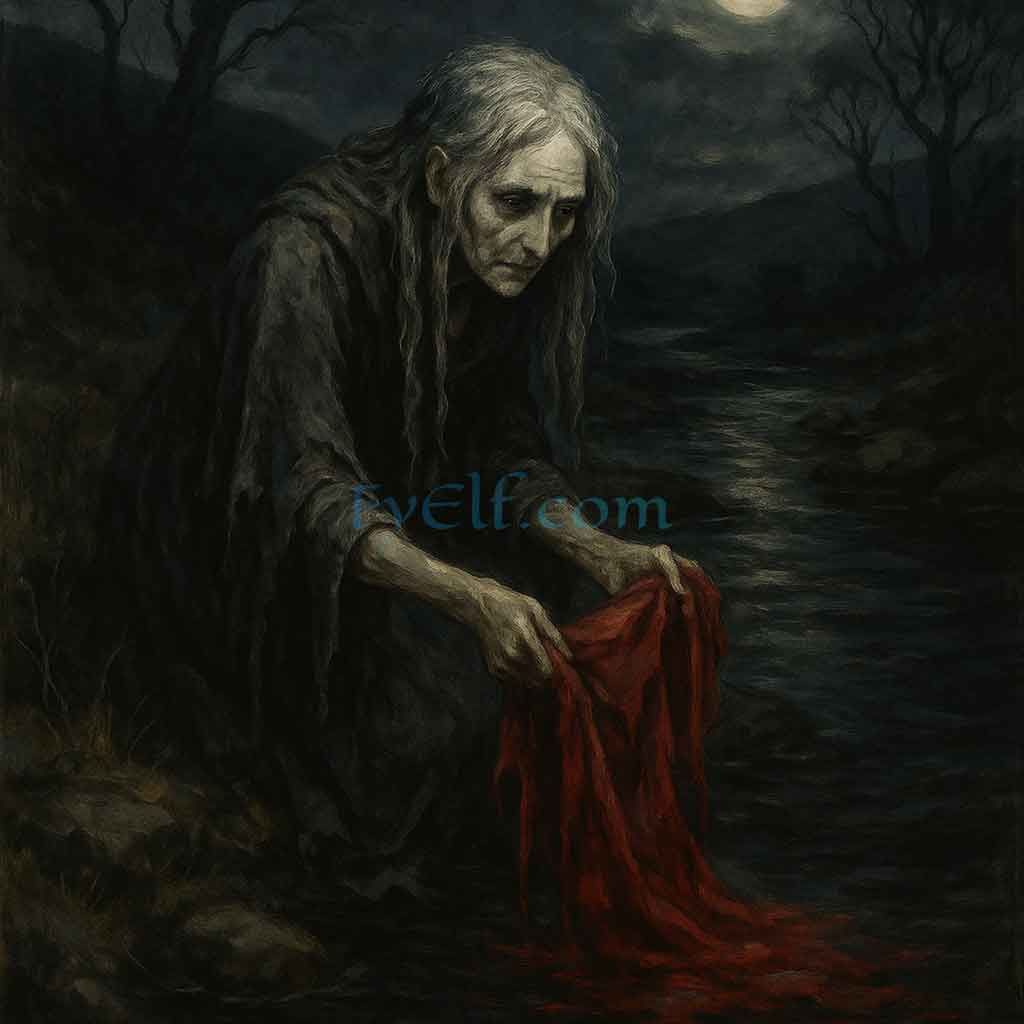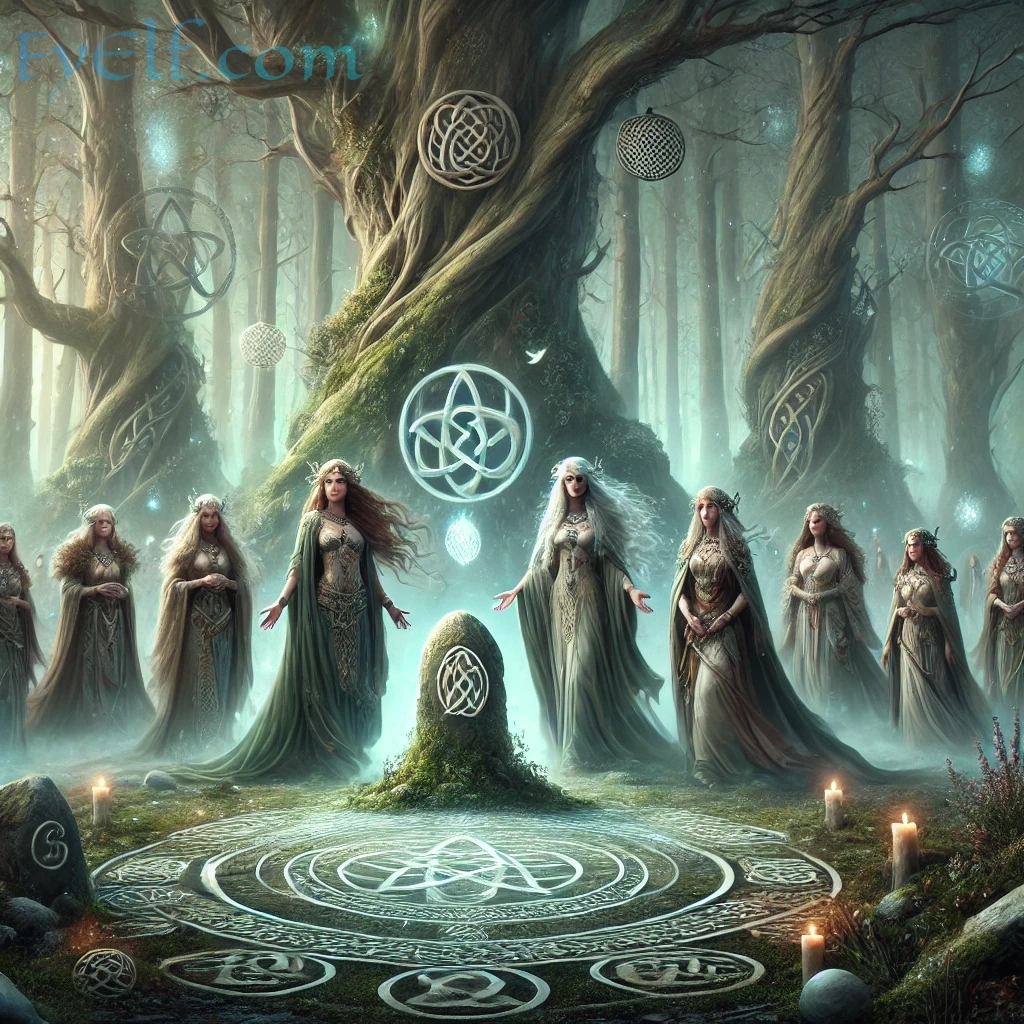Celtic mythology is filled with spirits who move between the worlds of the living and the dead. Among the most chilling is the Bean Nighe, the “Washing Woman,” who appears by streams and rivers, endlessly washing blood-stained clothes. Her presence is more than eerie—it is an omen of death. Rooted in Irish and Scottish folklore, the Bean Nighe belongs to the family of Celtic spirits of death, similar to the banshee, yet with a more haunting and solitary role.
Who Is the Bean Nighe? The Washing Woman of Celtic Folklore
The name Bean Nighe (pronounced “ban nee-yeh”) translates from Gaelic as “washing woman.” She is often depicted as a ghostly or fairy-like figure who washes the clothes or armor of those about to die. In this way, she serves as a harbinger of death, warning of imminent loss.
Like the banshee, the Bean Nighe is tied to death omens and funerary traditions, but her appearance is more direct—she physically enacts the washing of garments that belong to the soon-to-be dead.
Origins of the Bean Nighe in Irish and Scottish Tradition
The Bean Nighe appears in both Irish and Scottish Highland folklore, part of the wider Celtic belief in spirits who foretell or announce death.
- In Irish tradition, she is one of the “fairy women” associated with the Otherworld, connected to rivers, water, and fate.
- In Scottish folklore, particularly in the Highlands, she is often said to be the spirit of a woman who died giving birth, doomed to wander streams forever, washing shrouds until her task is done.
Her dual roots show how pagan Celtic ideas of fate merged with Christian concepts of sin and punishment, producing a spirit who is both a messenger and a restless soul.
Appearance and Traits: A Spirit of Death and Mourning
The Bean Nighe is usually described as a small, hag-like woman with:
- Red, webbed feet.
- Long, drooping breasts (sometimes tucked over her shoulders).
- A single large tooth or a single nostril in some versions.
- Blood-stained clothes in her hands.
Despite her grotesque form, she is not purely evil. Like the banshee, she serves as a warning figure, revealing what fate has already decided.
The Washing of Clothes: Symbolism and Meaning
The central act of the Bean Nighe is the washing of garments. Folklore holds that:
- She washes the clothes or armor of those about to die in battle.
- The washing signifies purification before death and a grim preparation for burial.
- If a passerby hears or sees her washing, it means that someone close—or sometimes the witness themselves—will soon die.
This act reflects Celtic symbolic associations of water with transition—a passage between worlds, cleansing the living into the realm of the dead.
Bean Nighe and the Banshee: Similarities and Differences
The Bean Nighe is often compared to the banshee, but there are key differences:
- Banshee: Cries or wails to announce death, often tied to noble families.
- Bean Nighe: Silently or mournfully washes garments, connected to rivers and solitary encounters.
Both are female spirits of death, but the banshee is more of a herald, while the Bean Nighe is a visual omen, making her encounters even more terrifying.
Encounters with the Bean Nighe in Folklore
Legends tell of eerie encounters with the Bean Nighe:
- Travelers passing rivers at dusk might hear splashing and discover her bent over, scrubbing clothes.
- If questioned, she might reveal whose clothes she was washing—and therefore who was destined to die.
- In some traditions, if one approached her respectfully and asked three questions, she would answer truthfully, but only if the person answered three of her own in return.
These encounters highlight her dual role as both a fearful omen and a keeper of hidden knowledge.
Symbolism of the Bean Nighe as Harbinger of Death
The Bean Nighe embodies deep Celtic themes:
- Death as inevitable fate—her washing cannot be undone.
- Water as a liminal space—a border between this world and the next.
- The mourning woman archetype—a figure that bridges grief, prophecy, and the supernatural.
She represents both the sorrow of death and the certainty of fate, blending Celtic myth with human fears of mortality.
The Legacy of the Bean Nighe in Modern Culture
Though less well-known than banshees, the Bean Nighe continues to appear in:
- Folklore studies as a unique symbol of Celtic death traditions.
- Fantasy fiction and games, often portrayed as spectral washerwomen or river hags.
- Contemporary Celtic storytelling, where she remains a figure of dread and fascination.
Her role as a solitary death spirit ensures that she stands out in the pantheon of Celtic mythical creatures, embodying both fear and prophecy.
Conclusion
The Bean Nighe of Celtic folklore is one of the most haunting death omens in Irish and Scottish tradition. Known as the “Washing Woman,” she appears by rivers, endlessly cleaning the garments of those soon to die. Unlike the banshee, who cries her warning, the Bean Nighe silently reveals fate through her grim task.
As part of the Celtic mythical creatures tradition, she remains a reminder of the inevitability of death, the power of water as a threshold, and the sorrow carried by those who see what others cannot.




